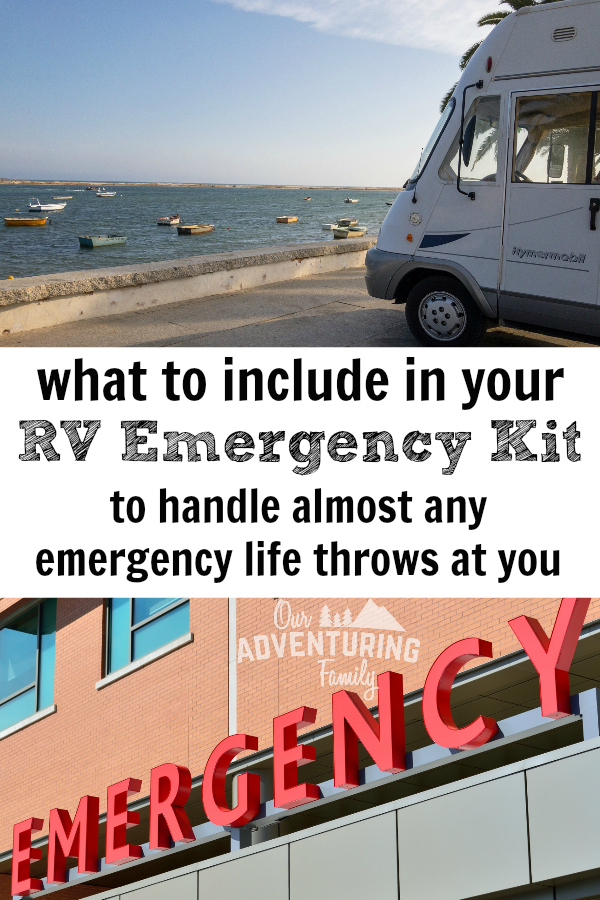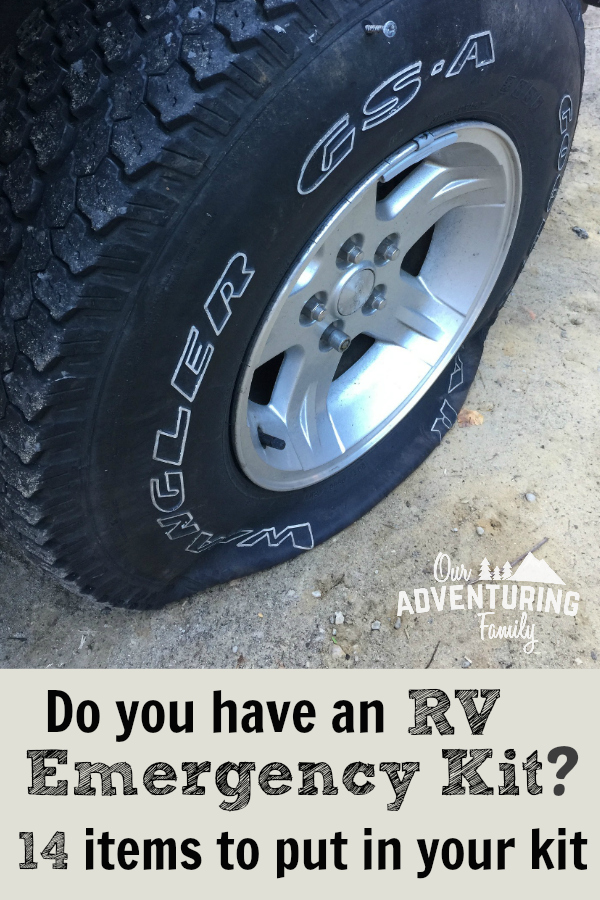This post may contain affiliate links. As an Amazon Associate I earn from qualifying purchases, but there is no additional cost for you. Please see my Disclosure page for more information.
Last week I shared our experience with a window in our RV shattering as we drove down the freeway. Thankfully, there was a WalMart about 10-15 minutes away and we were able to drive there to find what we needed to patch it up as best we could.
As we drove, we realized that while we were prepared for some things, we weren’t prepared for a broken window. We carry tools, headlamps, a weather radio and a battery jumper, but we didn’t have anything to cover the window. Good thing it wasn’t raining that night!
So what should you carry with you when you travel? Space can be limited and it’s hard to anticipate all the accidents you could face (like that shattered window). Here’s 14 things that will help you deal with most any emergency you have while on the road or camping, while not taking up a lot of space.
The handle-all-emergencies travel kit
1. A weather radio
I mentioned our weather radio when I talked about our trip to Badlands NP, but why would we want a weather radio if we have a radio in the RV and our cellphones? If your RV battery dies or you’re in an area with no cell signal, a weather radio can keep you abreast of local weather conditions. Our weather radio runs on a hand crank, so there’s no batteries to die at inopportune times. We can always find out about impending weather issues, regardless of where we are or what our power situation is.
2. A headlamp
Don’t try to juggle a flashlight while peering into the toilet or inspecting the underside of your rig. Put a headlamp on and keep your hands free and your flashlight out of the black tank or mud puddle. We have a number of headlamps scattered around our house and RV, because you never know when you’ll need one.
3. Rain gear
This is one area we could improve on, even if it’s just a cheap rain suit. We all have rain jackets, but we don’t have rain pants. The pouring rain storms we drove through this summer helped us realize that if we’d had to do anything outside, we would have gotten soaking wet.
4. Plastic sheeting with tape
When Jeremy went to WalMart, I thought he’d bring back some duck tape and leaf bags (you know the kind: giant, thick plastic trash bags) to patch the window. When he got back out to the RV though, he showed me something even better: a plastic drop cloth with tape attached to one edge. That taped edge made it so much easier to get the window patched up. The drop cloth was quite large, so we were able to double it up on the inside and the outside. Keep a roll of plastic sheeting on hand so you don’t have to try to find some after a window breaks or something else needs to be patched up.
5. Gorilla tape
We taped all the edges of the plastic with Gorilla tape. If you’re not familiar with Gorilla tape, it’s super sturdy duck tape with better adhesive qualities. After making sure all the edges were smoothed down, we didn’t have any problems with the tape coming off. It also lasted through several torrential rain storms after we returned home, while we waited for our replacement window to arrive. We may have had a broken window, but we didn’t need water damage as well. Like duck tape, Gorilla tape has myriad uses and can be used to MacGyver your way out of just about any unfortunate situation.
6. Battery jumper
RV batteries can be drained very easily. If you’ve ever had to jump start a dead battery, you know how inconvenient it can sometimes be to find another vehicle for that jumpstart. Carrying a battery jumper eliminates the need to find a vehicle that can get close to yours, which isn’t always possible in tight campgrounds. And if you’re boondocking alone, you won’t be left stranded.
7. Air compressor
If you have a tire running flat and there’s no truck stops nearby, use this portable air compressor to inflate that tire. It works best if your tire isn’t completely flat and is another must if boondocking or road tripping.

8. Tire jack and lug wrench
Don’t assume that you have a tire jack and lug wrench in your truck or RV. Before you hit the road, make sure you have them and that you know how to use them when changing a flat tire.
9. Small tool kit
We have a small tool bag that came with a variety of tools. We’ve added ratchets and a socket set that fit the screws and bolts in our RV. This makes it easy to access the water heater, winterize, and so on. We also keep an extra headlamp in the tool bag so it’s on hand when we need it.
10. Rope
Rope has so many uses: tie something on that got torn off, bundle something together, be a make-shift leash for a wayward pup, and so on. This paracord is lightweight, yet strong, and will do for most of your rope-tying needs.
11. Wire
Like rope, wire can have a number of uses. Combine rope and wire with your Gorilla tape, and you can take care of almost anything life throws at you 🙂
12. Shovel
Keep a shovel on hand to shovel sand or dirt for traction if you get stuck or need to dig a hole. It doesn’t need to be a full size shovel, it could be a folding camp shovel that doesn’t take much space, but is still effective.
13. First Aid Kit
It’s always good to have a first aid kit on hand. A first aid kit like this one will get you started, and you can add anything else that you personally might need. We keep first aid kits in both our cars and our RV, and I am always glad we do. We’ve used them all on a number of occasions, and it’s reassuring to know that we’ve got ointment, bandaids, gauze, and tape when we need them.
14. Cash and/or a credit card
Despite your best efforts, you may still need professional help. Make sure you have the resources available to pay for a tow truck and an Uber, and a night or two in a hotel. If you break down or get in an accident and your RV ends up in the shop, you will need them. Having emergency cash or an emergency credit card on hand will make a stressful situation a little easier to handle.
What would you add to this list? Have you used any of the items I’ve shared here?



Amazon delivery is horrible. Won’t buy from them. Too bad they seem to be your main source of goods.
Thanks for taking the time to leave a comment! Sorry you’ve had problem’s with Amazon’s delivery- I know it can be hit-or-miss, especially lately. I link to products on Amazon just to make it easy for my readers to see what I’m talking about.
We buy our RV gear from Amazon, WalMart, RV dealership shops, mom and pop shops, wherever we can find the items we’re looking for at the time.